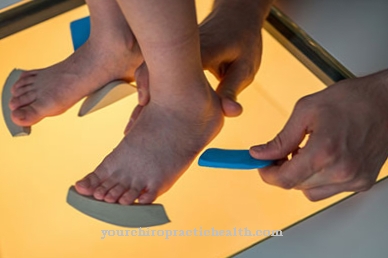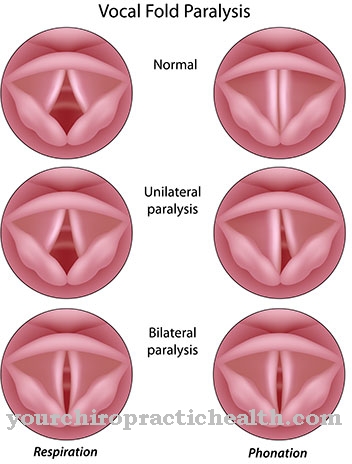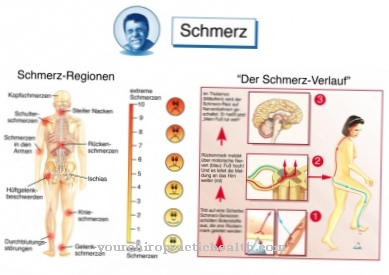Foot pain is immediately perceived as restricting movement. If the normal rolling process over the big toe is not pain-free in the long term, osteoarthritis like the Hallux rigidus be the cause. This disease does not only affect the elderly.
What is hallux rigidus?

© designua - stock.adobe.com
Hallux rigidus is the term used to describe osteoarthritis of the base joint of the big toe. The disease initially occurs with pain and a clearly visible increase in the circumference of the ball of the foot and can gradually lead to the stiffening of the joint.
The restriction of movement of the big toe is characteristic. Hallux rigidus usually only affects one foot and occurs regardless of age, but more often in men than women. Depending on the severity of the disease, hallux rigidus is divided into four stages, which are represented by an increase in pain and restricted mobility.
causes
A cause for the occurrence of hallux rigidus can usually not be found. A hereditary predisposition and minor injuries to the metatarsophalangeal joint can be a possible cause. Incorrect loads or overloads can also play a role.
As a result, hallux rigidus occurs more often in patients with gout, as the longitudinal arch of the foot flattens out and the foot is bent inward as a result. This leads to an incorrect load on the basal joint of the big toe and thus to hallux rigidus.
Symptoms, ailments & signs
The main symptom of hallux rigidus is pain in the area of the big toe. These are usually permanent, but can become stronger with particular stress and movement. The big toe can only be moved upwards with severe pain. In the case of advanced hallux rigidus, the joint can also be completely blocked.
You may hear pieces of cartilage and bone rubbing against each other when you move the joint. Usually there is swelling and sometimes redness. Especially when hallux rigidus is beginning, the short foot muscles may twitch visibly. Bony extensions often form on the back of the foot above the big toe.
These are mostly very sensitive to pressure. Pain occurs when stepping on the affected foot. For this reason, the position of the feet is also changing increasingly. The foot does not roll properly when walking. Those affected put on the outer edge of the foot, which can also cause calluses in the affected areas.
After a while, the joint will become increasingly rigid. In addition, patients with hallux rigidus often perceive a lack of space in the shoe. The symptoms increase at low temperatures. Hallux rigidus usually affects only one foot.
Diagnosis & course
The diagnosis of hallux rigidus can be made by the doctor based on an examination and the patient's medical history. X-rays are taken to determine the severity of the disease. In the case of hallux rigidus 1st degree, the mobility of the big toe is reduced by 20 to 50 percent and pain can be seen at times when it is exerted.
In the 2nd degree, the ability to move is reduced to up to 75 percent with severe pain. The joint space is shown reduced on the X-ray. The 3rd degree is characterized by a further restriction of movement, whereby the big toe can no longer be moved upwards. Patients experience constant pain, which gets worse when they walk. The joint space is almost no longer there.
With hallux rigidus 4th degree there is a complete inability of the basic joint to move. The pain is very severe and increases with the strain on the foot. In the worst form of hallux ridigus, the x-ray no longer shows an existing joint space.
Complications
In most cases, hallux rigidus causes severe pain in the foot. This pain mainly results in restricted mobility. Ordinary running, walking and standing are usually no longer possible. Sports activities are also no longer feasible for those affected. The restricted mobility and the permanent pain often lead to depression and other psychological complaints.
Under certain circumstances, irritability or aggressiveness can develop in the patient. Hallux rigidus puts an incorrect load on the foot so that the symptoms usually only worsen if no treatment is given. The patient is severely restricted in his everyday life by the disease and can no longer easily carry out various activities. This leads to a strong reduction in the quality of life.
Treatment of hallux rigidus does not lead to further complications. It takes place with the help of medication or surgery and in most cases leads to a positive course of the disease. In some cases, part of the big toe needs to be removed. Hallux rigidus does not affect life expectancy.
When should you go to the doctor?
Since hallux rigidus causes severe pain, an examination and treatment by a doctor is unavoidable. This can prevent further complications. As a rule, the doctor should be consulted in the case of hallux rigidus if the disease leads to severe restrictions on the big toe. The toe hurts, and the pain itself can spread to the entire foot.
Hallux rigidus also causes incorrect loading of the foot, so that the person concerned often has to adopt a poor posture or a relieving posture. Limping or limping can also indicate the disease. If the symptoms cannot be explained by an accident and occur over a longer period of time, a visit to a doctor is definitely recommended.
Hallux rigidus can be diagnosed and treated by an orthopedic surgeon or a general practitioner. As a rule, the discomfort is relieved well with the help of insoles. There are no particular complications.
Doctors & therapists in your area
Treatment & Therapy
Depending on the stage of hallux rigidus, there are various treatment options. For arthrosis of the 1st and 2nd degree, conservative treatments are in the foreground. They are designed to relieve pain and swelling and reduce stress on the joint. These include anti-inflammatory drugs and insoles for shoes.
Physical therapy exercises can help improve joint mobility. However, this does not reduce joint wear. In addition, patients should avoid tight shoes. Footwear with plenty of space for the toes and balls of the feet is also suitable for orthopedic insoles. Surgical removal of the protruding bones can also be performed up to degree 2 hallux rigidus. The cheilectomy is intended to restore mobility.
Choosing the right surgical technique depends on the age and activity level of the patient. In younger patients, arthrodesis is often the surgery of choice. Here the base joint is stiffened. Pain-free rolling is then possible again because the mobility in the toe joint is retained. A Keller-Brandes operation is mainly performed on older patients, as part of the base phalanx of the big toe is removed and this shortens as a result.
The use of a joint prosthesis is also possible with hallux rigidus. However, the durability and resilience of these prostheses are limited, so that replacement operations are necessary.
Outlook & forecast
As long as the stiffening of the big toe is in the early stages, there is a good chance of recovery. Then you don't have to undergo an operation. Numerous conventional treatment methods are available.These include the intake of body building materials, anti-inflammatory drugs, orthopedic shoe insoles and physiotherapy, for example.
It is different if the disease progresses rapidly. Then standing and walking is only possible with pain. Long distances can no longer be covered at all. Then only an operation will help. This is associated with similar risks as with other operations.
Those affected can also help prevent the hallux rigidus disease from worsening. In the early phase in particular, you are responsible. This begins, for example, with regular wearing of suitable shoes. In wide and soft footwear, the toes find enough space and pain does not even arise.
Consistent exercises on the big toe also prevent stiffening. Physiotherapists introduce sick people to the training. Follow this and other advice from professionals and doctors. This avoids an operation whose positive outcome is not always certain.
prevention
There is no effective prevention for hallux rigidus. Incorrect strain and overload should be avoided by using suitable footwear. This is especially true for runners, but also for everyone who is exposed to a lot of stress on the feet at work, because hallux rigidus can occur at any age.
Aftercare
In most cases of hallux rigidus, the patient has very few follow-up measures available. Early diagnosis is very important for this disease so that further complications or worsening of the symptoms can be avoided. Independent healing cannot occur, so that the person affected should consult a doctor at the first signs and symptoms of this disease.
In most cases of hallux rigidus, insoles are used for shoes to alleviate the symptoms. Medicines can also be taken to relieve inflammation. When taking it, it is important to ensure that the dosage is correct and that it is taken regularly. In some cases, however, surgery is necessary to permanently alleviate the symptoms.
The affected person should rest after the procedure and refrain from strenuous or physical activity. If the disease only occurs in old age, a prosthesis can be used to combat the symptoms. As a rule, this disease does not have a negative impact on the life expectancy of the person affected.
You can do that yourself
Since the pain in an existing hallux rigidus is often very pronounced, pain treatment is of great importance in therapy. In addition to painkillers, those affected can use over-the-counter pain relief ointments. Foot baths, wraps and cold-blooded hip baths are also recommended.
In addition, it is extremely important to relieve the affected joint in order to inhibit the inflammatory reactions. Physical exertion and sport must therefore be avoided. Instead, the foot should be elevated and, if necessary, cooled with cold packs to encourage swelling and relieve pain.
Well-fitting footwear is also very important for Hallux rigidus. Under no circumstances should the shoes be too tight. Instead, they should have enough space for the toes and balls of the feet to avoid pressure points. At the same time, sufficient stability must be guaranteed at all times.
In many cases it is also necessary to wear special insoles. The following applies here: If the doctor prescribes insoles, these must be worn regularly - i.e. daily - in order to increase the chances of successful treatment. If physiotherapy is required, the patient must also actively participate here so that improvement can be achieved quickly.






.jpg)

















.jpg)



